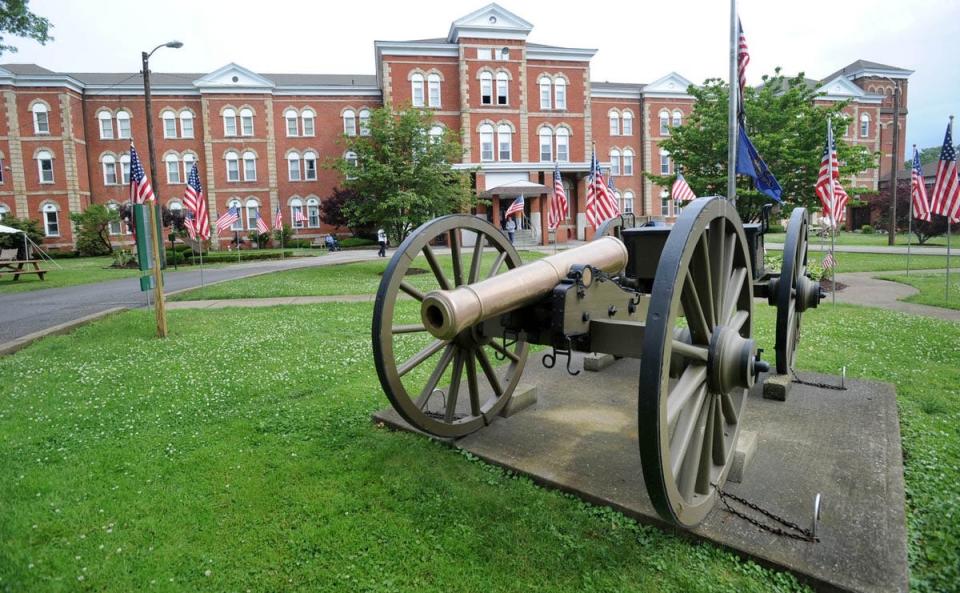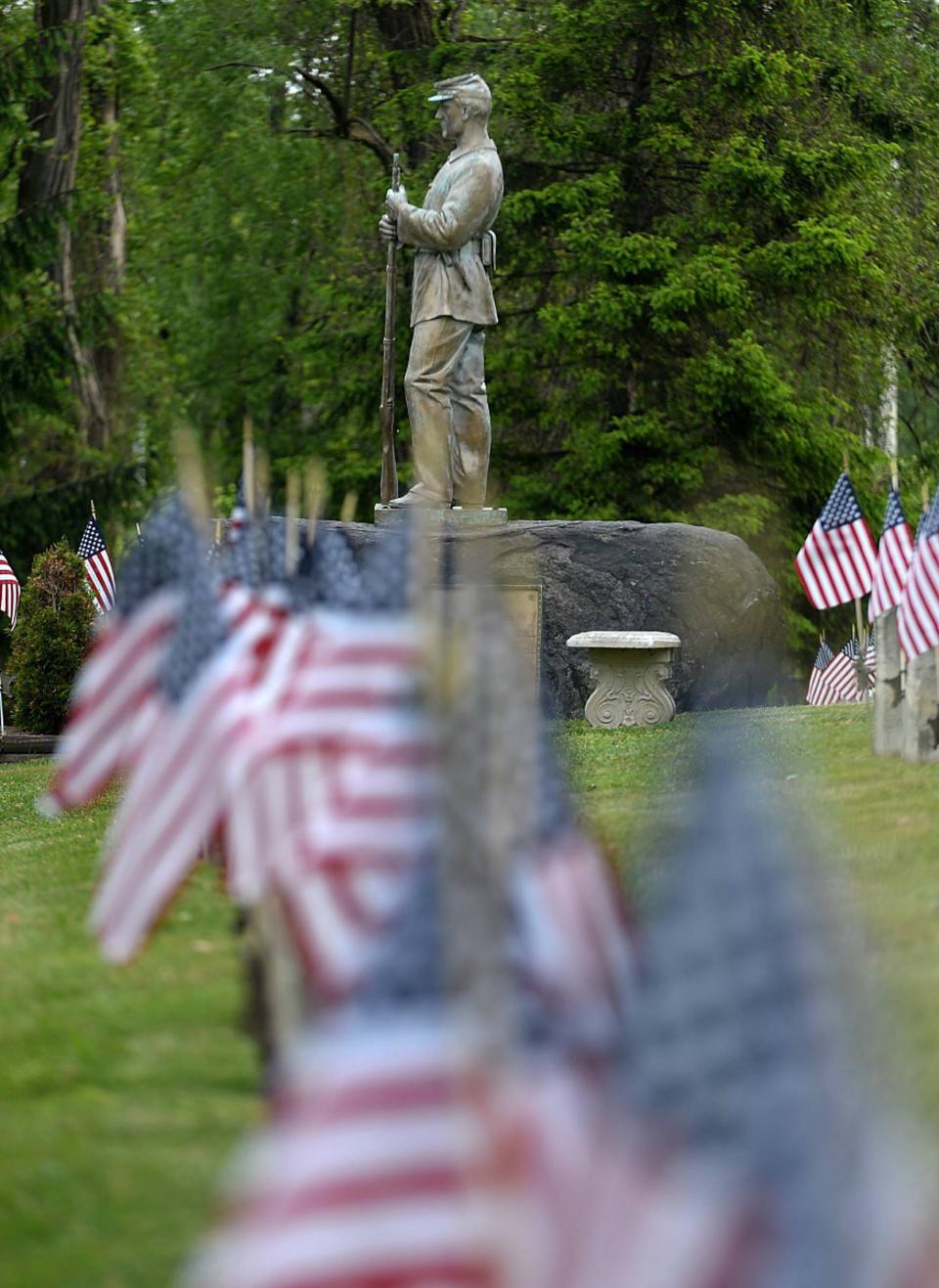Learn about the Civil War veterans who were the first Erie soldiers' home residents
The first Memorial Day observance at the Pennsylvania Soldiers' and Sailors' Home in Erie on May 30, 1887, was "impressive in the extreme," according to the Erie Morning Dispatch. The home had been opened at the foot of Ash Street a year earlier for infirm and indigent Civil War veterans.
"The veterans of many battles were congregated in the chapel and there listened to the addresses and songs which brought back old army days," the Dispatch reported.
The addresses included Gen. John A. Logan's order designating May 30, 1868, as a remembrance day for Civil War dead. A children's choir sang "America" and "Nearer My God to Thee," bringing "many tears to the eyes of the veterans."
For the veterans, the Soldiers' and Sailors' Home was "a haven of rest for those who, having fought for the salvation of their country, found themselves in their old age, crippled, without homes or the means of smoothing the downward paths of their declining years," the Dispatch reported on the home's Feb. 22, 1886, opening.

There were 27 initial residents. By 1890, the facility was home to more than 400 former Union soldiers and sailors.
The Pennsylvania Soldiers' and Sailors' Home has since housed veterans of every American war and today is operated by the Pennsylvania Department of Military and Veterans Affairs.
Those who fought
Early Soldiers' and Sailors' Home residents and staff were regularly featured in the Erie Morning Dispatch, often in brief obituaries when the old Civil War veterans "mustered out."
Their ranks included immigrants, U.S. Colored Troops veterans, a sailor recognized by Congress for heroism in the Mexican War, a victim of an Erie "highwayman" and a Johnstown Flood survivor:
Jacob Armbruster, 54, died on Oct. 14, 1888, and was buried in the cemetery on the grounds. Born in Germany, "he enlisted in the Union army only a few days before the battle of Bull Run on the 9th of July, 1861, and fought the battles of his adopted country until she had no foes," serving with the 6th U.S. Cavalry and 5th Pennsylvania Cavalry. He had been a blacksmith in Oil City.
S.F. Chapin was appointed resident physician and surgeon at the home in 1889. He was raised in Lowville and earned medical degrees from Yale and Michigan University. He served as a surgeon with the 1st Pennsylvania Reserve and 139th Pennsylvania Infantry and rose to be a brigade surgeon-in-chief in the Sixth Corps, Army of the Potomac, treating wounded at Second Bull Run, Antietam, Gettysburg, the Wilderness, Spotsylvania, Cold Harbor and other bloody battles.
Gottleib Miltenberger left the Soldiers' and Sailors' Home to attend Pennsylvania Day observances at Gettysburg in mid-September 1889. "He was run over by a vehicle during the manoueuvres which formed a part of the programme of the occasion, and suffered injuries from which he could not recover." He was buried at the National Cemetery at Gettysburg.
Chas. D. Wharton died at the home on Oct. 9, 1889. He served in the navy during the Mexican War and during the 1847 siege of Veracruz was "one of a small number who rowed ashore and in a hand to hand fight, with cutlasses, drove back a squadron of Mexican lancers who had surrounded Gen. Phil Kearney, and rescued their general." Wharton enlisted in the 11th Pennsylvania Infantry at the start of the Civil War and fought at Antietam, Gettysburg and other battles throughout the war.
Michael Stormer, "an old and infirm member of the Soldiers' and Sailors' Home," was held up and robbed at gunpoint on his way to revival services at Tenth Street M.E. Church in December 1889. "He was between Sixth and Seventh streets on Ash Lane when a villainous looking man sprang out from behind Daugherty's confectionary store and presenting a revolver demanded his money or his life." Stormer gave the man all he had, 25 cents.
Samuel Couch, of Huntingdon, served in the 22nd Pennsylvania Cavalry. After his death at the Soldiers' and Sailors' Home on Jan. 30, 1890, his body was sent home for burial. "The remains were taken to the depot on the new funeral car, which is a platform placed on top of a caisson, and is very appropriate for the purpose for which it is used. The casket this afternoon was wrapped in the flag, and a guard of honor marched alongside while an escort of comrades, with flute and drum corps, led the funeral procession."
James C. Clifford, a Black man, died at the home on June 3, 1890. "He was a member of a well-known family of colored people, long respected residents of Erie. John Clifford nearly half a century ago managed the principal barber shop of the city, occupying a store in the Reed House and afterwards the shop now occupied by Albert Vosburg. He was a brother of Mrs. Wm. Bladen, of Millcreek, one of the most prosperous of Erie county farmers." Clifford served in the 6th Regiment, U.S. Colored Troops, from December 1863 until Jan. 11, 1865.
Cornelius Engelbert, of Delaware County, died at the home on Nov. 30, 1891, and was buried from St. Patrick's Cathedral. He joined the 19th Pennsylvania Infantry the day before the April 1861 Confederate attack on Fort Sumter and later served with the 1st Corps D'Afrique Engineers and as a lieutenant with the 95th Regiment, U.S. Colored Troops.
John Peterson, veteran of the 3rd, 11th and 19th Pennsylvania Cavalries, was admitted to the Soldiers' and Sailors' Home in January 1892. Peterson had been on his way home in Johnstown on May 31, 1889, when he saw the wall of water, trees and rocks hit his house. His wife and four children died. Peterson was carried with the flood and was in the water for 18 hours before rescue. "Peterson is unable to get warm and has never been comfortably warm since his terrible ordeal in the flood; he has blankets piled on top of him in his bed and while others are almost roasting he is freezing."

'Boys in blue at their games'
Regular church services and lectures were provided for Soldiers' and Sailors' Home residents.
Entertainment was provided by Erie church, school and civic groups, including the Society of Christian Endeavor of the First Presbyterian Church, which earned "generous applause" for a program including a recitation, piano and vocal solos, and select readings, according to the March 21, 1889, Erie Morning Dispatch.
Veterans also performed.
"Visitors to the Soldiers' and Sailors' Home are always attracted by the... strains of the violin playing which come from one of the rooms on the first floor," the newspaper reported on Jan. 23, 1892.
The musicians were Charles Henderson, formerly of the 196th Pennsylvania Infantry, and William Keefer, formerly of the 7th Pennsylvania Cavalry. Both men were blinded during the war and "while whiling away their own blank existence, contribute much to the cheerfulness of the Home."
Residents additionally attended concerts and shows in Erie, including a matinee performance of "Galaten" at the Central Opera House at the invitation of Claire Scott, the star of the play, in February 1889.
In May of that year, "a veteran at the Soldiers’ and Sailors’ Home held ticket No. 1413, which drew the silver water set given away by the Sawtelle Comedy Company at the Park Opera House."
More than one Soldiers' and Sailors' Home resident frequented Erie saloons.
Frederick Wilhelm, a Prussia-born veteran of the 7th Pennsylvania Infantry and 5th Pennsylvania Cavalry, tried to drown himself in Lake Erie on July 5, 1888. "He had been drinking quite heavily of late, and this is the principal cause of his attack on his own life," according to the next day's Dispatch.
"Geo. Blythe, an inmate of the Soldiers’ and Sailors’ Home, was before Alderman McMahon this morning, and his appearance there cost him $8. His conduct at the Home has been very bad, caused by over-indulgence in whisky," according to the March 13, 1889, Dispatch.
On Sept. 11, 1889, the home's commander, Maj. W.W. Tyson, cautioned saloonkeepers "to be careful not to violate the law by selling intoxicating liquors to members of the Home family who are persons of known intemperate habits."
Ninety of every 100 disciplinary issues at the home "are occasioned by strong drink," Tyson told the Dispatch.
An "amusement hall" including reading room, library, smoking room and game room was opened in the Soldiers' and Sailors' Home in 1891 and may have kept more temperate residents out of the local saloons and pool halls.
"Last evening every table on the second floor was filled with boys in blue at their games," the Morning Dispatch reported on Dec. 11, 1891.
The 'haven of rest'
The Pennsylvania Soldiers' and Sailors' home was built beginning in the 1860s as a marine hospital for sick and disabled Great Lakes sailors. Though the state appropriated $90,000 for its construction in 1867 and later appropriated more, the hospital was never completed, according to John Miller's 1909 "Twentieth Century History of Erie County, Pennsylvania."
When the state legislature in 1885 created a commission to establish and maintain a home for disabled soldiers and sailors, it quickly determined that the never-opened marine hospital was ideal. It was owned by the state, "was located in a most desirable spot, with a tract of more than 100 acres of ground around it, and, moreover, construction upon a really admirable plan carried well along," Miller wrote.
The home's Feb. 22, 1886, dedication ceremonies included a parade from State Street to the facility led by U.S.S. Michigan sailors and marines and also including Civil War veterans' post commanders, Koehler's Band, and Pennsylvania Gov. Robert Pattison.
"The decorations were liberal, nearly all the business places and residences on the route having thrown flags and decorations to the breeze, testifying to the best of their abilities their appreciation of the important event then being celebrated," according to the Dispatch.
Veterans who would be living at the home, Pattison said during the dedication, were among "the heroic sons of Pennsylvania (who) poured forth from every valley and hillside to take their places in the greatest legion of the Union... and stood their ground till the victory was won."
Contact Valerie Myers at vmyers@timesnews.com.
This article originally appeared on Erie Times-News: Memorial Day: Civil War vets 'mustered out' at Erie soldiers' home

